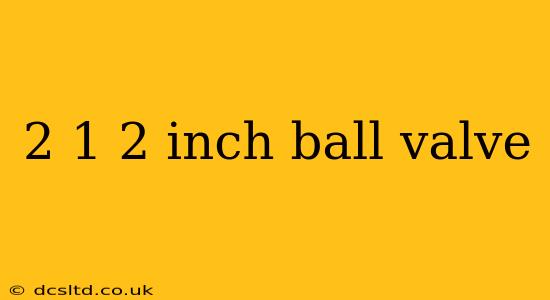Decoding the 2 1/2 Inch Ball Valve: A Comprehensive Guide
Finding the right ball valve for your needs can feel overwhelming with the sheer variety available. This guide focuses specifically on the 2 1/2 inch ball valve, explaining its features, applications, and things to consider when selecting one. We'll delve into the specifics, ensuring you have the knowledge to make an informed decision.
What is a 2 1/2 Inch Ball Valve?
A 2 1/2 inch ball valve is a type of quarter-turn valve that uses a spherical "ball" to control the flow of fluid (liquid or gas) through a pipe. The "2 1/2 inch" refers to the nominal bore size – essentially, the inside diameter of the valve body where the fluid flows. This size is relatively common in various industrial and residential applications. The ball has a hole through its center, and rotating the ball 90 degrees either opens or closes the flow path. This simple, efficient design makes ball valves popular for their ease of operation and reliability.
What are the Different Types of 2 1/2 Inch Ball Valves?
Several factors differentiate 2 1/2 inch ball valves, making it crucial to understand your needs before choosing. Here are key distinctions:
-
Full Port vs. Reduced Port: A full-port ball valve has a flow passage that's the same diameter as the pipe, minimizing pressure drop. A reduced-port valve has a smaller flow passage, impacting flow rate. The choice depends on your application's pressure and flow requirements.
-
Material: Ball valves are manufactured from various materials such as brass, stainless steel, PVC, and others. The material choice depends on the fluid being handled and the operating conditions (temperature, pressure, corrosive environment). Stainless steel is a common choice for its durability and resistance to corrosion.
-
End Connections: These valves can have various end connections, including threaded (NPT), flanged, or welded. The type of connection needed will depend on your existing piping system.
-
Lever vs. Gear Operation: Smaller valves often feature a lever handle for manual operation, while larger ones might utilize a gear mechanism for easier control, especially in high-torque situations.
Where are 2 1/2 Inch Ball Valves Used?
The versatility of the 2 1/2 inch ball valve leads to its use in a wide array of applications, including:
- Industrial Processes: Controlling the flow of liquids and gases in manufacturing plants, chemical processing, and oil and gas industries.
- Water Distribution: In municipal water systems and irrigation systems.
- HVAC Systems: For regulating the flow of water or refrigerant in heating and cooling systems.
- Residential Plumbing: In larger residential or commercial plumbing systems, for isolating sections of piping for maintenance or repair.
What are the Advantages of Using a 2 1/2 Inch Ball Valve?
- Simple Operation: The quarter-turn design makes them easy to open and close.
- Tight Shut-off: They provide a reliable seal, preventing leakage.
- Compact Design: They are relatively small and space-saving compared to other valve types.
- Durable: With proper selection and maintenance, they can last for many years.
- Cost-effective: Generally, they are a cost-effective solution for many fluid control applications.
How Do I Choose the Right 2 1/2 Inch Ball Valve for My Needs?
Selecting the appropriate valve requires careful consideration of the following:
- Fluid Type: The type of fluid (corrosive, abrasive, etc.) dictates the material choice.
- Operating Pressure and Temperature: The valve's pressure and temperature ratings must exceed the anticipated operating conditions.
- Flow Rate: Full-port valves are ideal for high flow rates, while reduced-port valves are suitable for lower flow rates.
- Pipe Size and Connection Type: Ensure compatibility with your existing piping system.
- Operating Mechanism: Choose between lever or gear operation based on the valve size and desired ease of use.
By carefully considering these factors, you can ensure you choose the correct 2 1/2 inch ball valve that meets your specific needs and provides long-term reliable service. Remember to always consult relevant industry standards and manufacturer specifications for detailed information.
